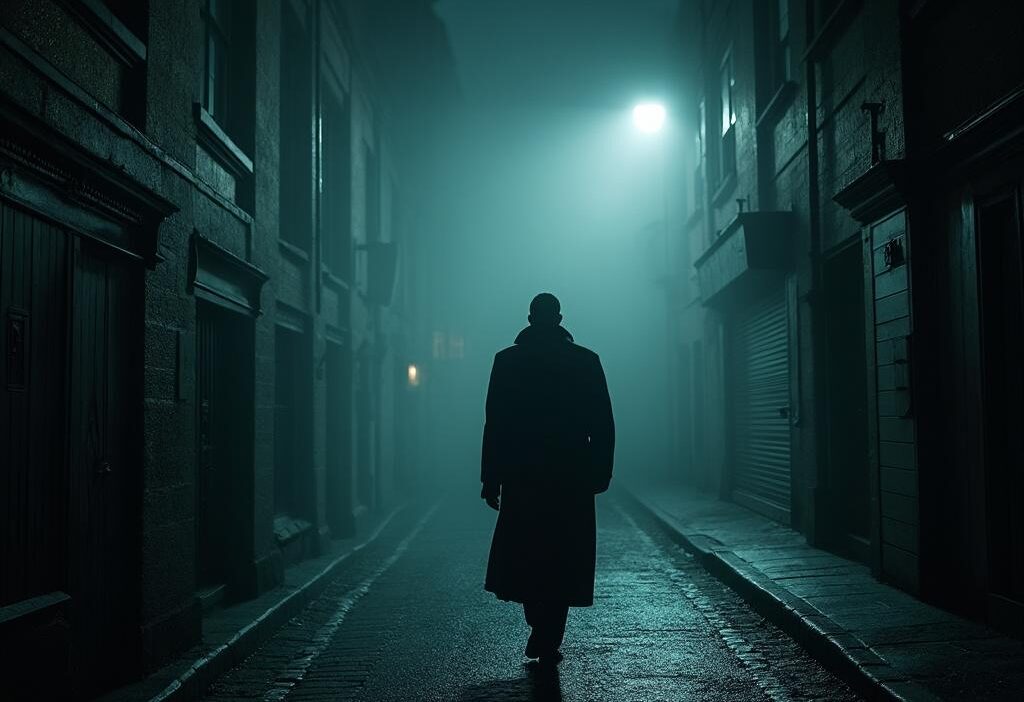Exploring Netflix’s ‘Dept. Q’ A Deep Dive into Its Noir-Inspired Crime Drama
Netflix’s Dept. Q merges the chilling atmospheres of Nordic, British, and American noir into a gripping crime drama set in Edinburgh. Following detective Carl Morck and his team of misfits, the series delves into cold cases with a dual-perspective narrative that captivates and thrills. This article explores the series’ plot, style, cast, and its unique blend of noir traditions.
The Genesis of Dept. Q
Dept. Q began as a bestselling book series by Danish author Jussi Adler-Olsen, whose dark, intricate plots redefined Nordic noir. The novels introduced Carl Mørck, a disgraced detective relegated to Copenhagen’s cold case unit, where he and his unconventional team unravel decades-old mysteries. Netflix’s adaptation, while staying true to the source material, expands its noir influences, blending British grit and American suspense into its Danish core.
The creative team, led by showrunner Torleif Hoppe (The Bridge), aimed to preserve Adler-Olsen’s brooding atmosphere while enhancing visual storytelling. Cinematographer Jesper Tøffner employed shadow-laden frames and muted tones, evoking classic noir, while the writing team sharpened the dialogue to reflect the series’ transatlantic appeal. Casting Matthew Goode as Mørck added a British sensibility, bridging the gap between Nordic austerity and Hollywood charisma.
The adaptation’s success lies in its fidelity to the books’ psychological depth, while reimagining Edinburgh as a character—its foggy alleys and austere architecture amplifying the show’s haunting tone. By merging Adler-Olsen’s layered narratives with a globally resonant noir aesthetic, Dept. Q transcends its origins, offering a fresh take on the genre.
A Tale of Two Investigations
In Dept. Q, the dual-perspective investigation into Merritt Lingard’s disappearance crafts a gripping narrative tension. While Carl Mørck’s team digs through cold case files, Lingard’s own harrowing ordeal unfolds in parallel, revealing fragments of truth that the detectives lack. This interplay between past and present, victim and investigator, deepens the mystery, forcing viewers to piece together clues alongside the characters. The contrast between Mørck’s methodical police work and Lingard’s desperate fight for survival heightens the stakes, blending procedural rigor with raw, emotional urgency. The structure not only amplifies suspense but also underscores the show’s noir roots—where justice is elusive, and every revelation comes at a cost.
The Heart of Noir Dept. Q’s Style and Mood
Dept. Q masterfully weaves Nordic, British, and American noir influences into its DNA, crafting a distinct visual and tonal identity. The series embraces Edinburgh’s brooding architecture—rain-slicked cobblestones, shadowy alleyways, and oppressive gray skies—to mirror the moral murkiness of its cases. The cinematography leans into high-contrast lighting, with stark shadows that evoke classic noir, while the muted color palette nods to Nordic noir’s bleak realism.
Morck’s world is steeped in moral ambiguity, a hallmark of noir, but the series injects dark humor to offset its grimness, a trait borrowed from British crime dramas like Luther. The dialogue crackles with sardonic wit, particularly in Morck’s exchanges with Rose and Assad, balancing the weight of unsolved horrors.
Where Dept. Q diverges from traditional noir is in its procedural structure, blending American pacing with European introspection. The show lingers on psychological torment, much like The Killing, but retains the hard-boiled cynicism of Chandler-esque detectives. The result is a hybrid style—unflinching yet textured, where every frame feels like a deliberate homage to noir’s legacy while carving its own path.
The Ensemble Behind the Mystery
The ensemble cast of Dept. Q elevates the series with nuanced performances that anchor its noir sensibilities. Matthew Goode delivers a magnetic portrayal of Carl Morck, blending world-weariness with sharp wit, embodying the flawed detective archetype while adding fresh depth. His chemistry with Chloe Pirrie, who plays the resilient Rose, adds emotional weight, their dynamic reflecting the show’s balance of grit and vulnerability. Alexej Manvelov shines as Assad, Morck’s enigmatic partner, whose quiet intensity contrasts with Morck’s cynicism, creating a compelling push-and-pull. The supporting cast, including Kelly Macdonald as the pragmatic DCI, enriches the narrative, their performances grounding the series in authenticity. Each actor breathes life into Edinburgh’s shadowy underbelly, ensuring the cold cases feel hauntingly personal. Their collective impact resonates, making Dept. Q a standout in the crime drama genre.
Nordic Noir’s Influence on Dept. Q
Dept. Q’s roots in Nordic noir are unmistakable, weaving psychological depth and stark atmospherics into its storytelling. The series mirrors the genre’s hallmark traits—protagonists burdened by trauma, morally ambiguous cases, and a pervasive sense of existential dread. Carl Mørck, portrayed by Matthew Goode, embodies this tradition, his fractured psyche reflecting the genre’s fascination with damaged detectives. The show’s visual language, with its muted tones and brooding Edinburgh backdrops, echoes the bleak landscapes of Scandinavian crime dramas, reinforcing its noir DNA.
Unlike traditional Nordic noir, however, Dept. Q tempers its darkness with moments of dry humor, a nod to its British influences. Yet, its core remains anchored in the psychological unraveling of its characters, a signature of Nordic storytelling. The series’ cold cases, often tied to societal critiques, further align it with Nordic noir’s penchant for exploring systemic failures. By blending these elements, Dept. Q carves its own space within the genre, offering a fresh yet familiar take on noir’s enduring appeal.
British Noir A Local Flavor
Dept. Q’s Edinburgh setting infuses it with a distinctly British noir flavor, blending sardonic wit with the city’s brooding atmosphere. Unlike Nordic noir’s existential bleakness, the series leans into dry humor and bureaucratic cynicism, mirroring classic British crime dramas like Tinker Tailor Soldier Spy. The Scottish capital’s gothic architecture and misty alleyways provide a moody backdrop, evoking the claustrophobic tension of works by Ian Rankin.
Detective Carl Mørck’s abrasive yet darkly comic demeanor contrasts with the stoic protagonists of Nordic noir, adding a layer of British irreverence. The dialogue crackles with irony, a hallmark of UK crime storytelling, while the procedural elements feel more grounded in local policing quirks than American hardboiled tropes. This local texture—council estates, pub banter, and institutional inertia—sets Dept. Q apart, offering a noir that’s as much about place as it is about crime.
American Noir’s Procedural Roots
Dept. Q leans heavily into American noir’s procedural DNA, structuring each episode like a classic cold-case investigation. The series mirrors the hardboiled detective tradition, with Carl Mørck embodying the archetype of the disillusioned, rule-bending cop—a trope familiar from American crime fiction. His gruff exterior and personal demons echo protagonists like Philip Marlowe or Sam Spade, while the show’s methodical unraveling of clues pays homage to the meticulous pacing of Law & Order or True Detective.
The procedural framework keeps viewers hooked, blending forensic detail with psychological tension. Unlike British noir’s focus on local flavor or Nordic noir’s existential dread, Dept. Q adopts America’s obsession with solving crime, not just dwelling in its darkness. Flashbacks, witness interrogations, and red herrings are deployed with precision, creating a puzzle-like appeal. Even the partnership between Carl and Assad reflects the classic American buddy-cop dynamic—clashing personalities united by a shared mission.
This fusion of American grit with European melancholy broadens the show’s appeal, offering both the satisfaction of resolution and the weight of moral ambiguity. It’s noir with a clear endgame, a rarity in the genre’s often open-ended narratives.
Critical Reception and Audience Response
Dept. Q has garnered a largely positive critical reception, praised for its atmospheric tension and gripping storytelling. Critics highlight its seamless fusion of Nordic melancholy, British grit, and American noir tropes, with particular acclaim for its lead performances and chilling cinematography. However, some argue that the pacing occasionally lags, and the procedural format feels familiar.
Audiences have embraced the series, with strong viewership on Netflix, especially in markets favoring dark crime dramas. Fan discussions often center on the show’s intricate mysteries and the dynamic between its protagonists. While not without minor flaws, Dept. Q has solidified its place as a standout in the noir genre.
The Future of Dept. Q
With its gripping open-ended narrative and richly layered characters, Dept. Q has ample room to expand. Future seasons could delve deeper into Carl Mørck’s haunted past or explore Assad’s enigmatic background, adding psychological complexity. The show’s blend of Nordic austerity, British procedural grit, and American noir tension leaves space for darker, more intricate cases. Fans can anticipate sharper twists, deeper moral ambiguity, and perhaps even cross-border investigations that push the series beyond Edinburgh’s shadows. If Netflix greenlights more episodes, Dept. Q could evolve into a defining neo-noir saga.
Noir’s Enduring Appeal in Modern Storytelling
Dept. Q masterfully revitalizes noir for modern audiences by blending Nordic melancholy, British grit, and American hard-boiled tension. Its shadowy cinematography, morally ambiguous characters, and labyrinthine cold cases pay homage to classic noir while feeling fresh. The series taps into contemporary anxieties—bureaucratic inertia, systemic corruption, and the haunting weight of unresolved trauma—making its noir sensibilities deeply relevant. By grounding its darkness in Carl Mørck’s flawed humanity and Rose’s relentless pursuit of justice, the show transcends mere genre homage, offering a nuanced exploration of redemption. In an era saturated with true-crime narratives, Dept. Q stands out by weaving noir’s existential dread into emotionally resonant storytelling, proving the genre’s timeless ability to mirror society’s darkest corners.

Conclusions
Dept. Q stands as a testament to the power of noir-inspired storytelling, blending Nordic, British, and American traditions into a compelling crime drama. With its strong cast, innovative narrative structure, and atmospheric setting, the series offers a fresh take on the genre. As it leaves room for growth, Dept. Q promises to remain a staple for fans of dark, complex detective stories.



